
An effects unit or effects pedal is an electronic device that alters the sound of a musical instrument or other audio source through audio signal processing.

Ryland Peter Cooder is an American musician, songwriter, film score composer, record producer, and writer. He is a multi-instrumentalist but is best known for his slide guitar work, his interest in traditional music, and his collaborations with traditional musicians from many countries.
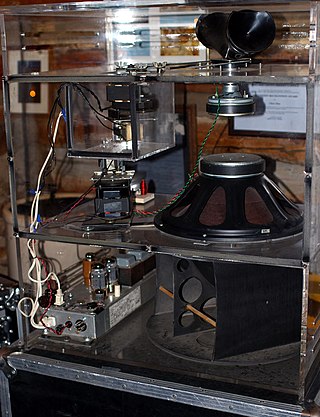
The Leslie speaker is a combined amplifier and loudspeaker that projects the signal from an electric or electronic instrument and modifies the sound by rotating a baffle chamber ("drum") in front of the loudspeakers. A similar effect is provided by a rotating system of horns in front of the treble driver. It is most commonly associated with the Hammond organ, though it was later used for the electric guitar and other instruments. A typical Leslie speaker contains an amplifier, a treble horn and a bass speaker—though specific components depend upon the model. A musician controls the Leslie speaker by either an external switch or pedal that alternates between a slow and fast speed setting, known as "chorale" and "tremolo".

A guitar amplifier is an electronic device or system that strengthens the electrical signal from a pickup on an electric guitar, bass guitar, or acoustic guitar so that it can produce sound through one or more loudspeakers, which are typically housed in a wooden cabinet. A guitar amplifier may be a standalone wood or metal cabinet that contains only the power amplifier circuits, requiring the use of a separate speaker cabinet–or it may be a "combo" amplifier, which contains both the amplifier and one or more speakers in a wooden cabinet. There is a wide range of sizes and power ratings for guitar amplifiers, from small, lightweight "practice amplifiers" with a single 6-inch speaker and a 10-watt amp to heavy combo amps with four 10-inch or four 12-inch speakers and a 100-watt amplifier, which are loud enough to use in a nightclub or bar performance.

Low-frequency oscillation (LFO) is an electronic frequency that is usually below 20 Hz and creates a rhythmic pulse or sweep. This is used to modulate musical equipment such as synthesizers to create audio effects such as vibrato, tremolo and phasing.

Crossroads is a 1986 American musical drama film inspired by the legend of blues musician Robert Johnson. Starring Ralph Macchio, Joe Seneca and Jami Gertz, the film was written by John Fusco and directed by Walter Hill and features an original score by Ry Cooder featuring classical guitar by William Kanengiser and harmonica by Sonny Terry. Steve Vai appears in the film as the devil's virtuosic guitar player in the climactic guitar duel.
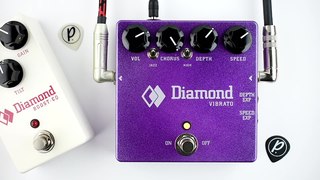
A vibrato unit is an electronic effects unit used to add vibrato to the sound of an electric instrument, most often an electric guitar. Vibrato units may be individual stomp boxes or built into multi-effects units, but are traditionally built into guitar amplifiers. Vibrato units are particularly used in surf music.

Chávez Ravine: A Record by Ry Cooder is the twelfth studio album by Ry Cooder. It is the first concept album and historical album by Ry Cooder which tells the story of Chávez Ravine, a Mexican-American community demolished in the 1950s in order to build public housing. The housing was never built. Ultimately the Brooklyn Dodgers built a stadium on the site as part of their move to Los Angeles.

A bass amplifier is a musical instrument electronic device that uses electrical power to make lower-pitched instruments such as the bass guitar or double bass loud enough to be heard by the performers and audience. Bass amps typically consist of a preamplifier, tone controls, a power amplifier and one or more loudspeakers ("drivers") in a cabinet.

Distortion and overdrive are forms of audio signal processing used to alter the sound of amplified electric musical instruments, usually by increasing their gain, producing a "fuzzy", "growling", or "gritty" tone. Distortion is most commonly used with the electric guitar, but may also be used with other electric instruments such as electric bass, electric piano, synthesizer and Hammond organ. Guitarists playing electric blues originally obtained an overdriven sound by turning up their vacuum tube-powered guitar amplifiers to high volumes, which caused the signal to distort. While overdriven tube amps are still used to obtain overdrive, especially in genres like blues and rockabilly, a number of other ways to produce distortion have been developed since the 1960s, such as distortion effect pedals. The growling tone of a distorted electric guitar is a key part of many genres, including blues and many rock music genres, notably hard rock, punk rock, hardcore punk, acid rock, and heavy metal music, while the use of distorted bass has been essential in a genre of hip hop music and alternative hip hop known as "SoundCloud rap".
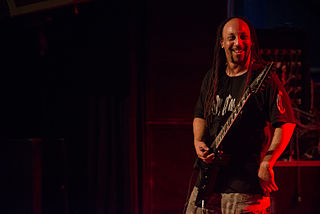
Terrance Hobbs is an American musician and the lead guitarist in the American death metal band Suffocation. Hobbs has been a constant member in the band since their first released title Reincremated along with bandmates Frank Mullen and Mike Smith, who all met in high school. Hobbs also played in the deathgrind project, Criminal Element, which featured fellow Suffocation member Derek Boyer.
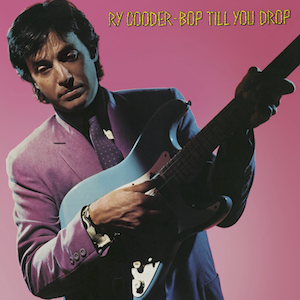
Bop Till You Drop is Ry Cooder's eighth album, released in 1979. The album was the first digitally recorded major-label album in popular music. Bop Till You Drop was recorded on a digital 32-track machine built by 3M.

Across the Borderline is the 40th studio album by Willie Nelson. It was produced by Don Was, Paul Simon, and Roy Halee. It includes songs written by Paul Simon, Ry Cooder, John Hiatt, Peter Gabriel, Bob Dylan, Lyle Lovett, and Nelson himself. Featured performers include David Crosby, Kris Kristofferson, Sinéad O'Connor, Bonnie Raitt, Bob Dylan, and Paul Simon.
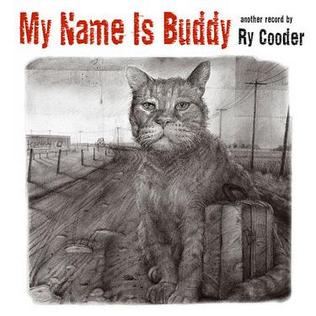
My Name Is Buddy: Another Record by Ry Cooder is the thirteenth studio album by Ry Cooder. It is the second social-political concept album by Ry Cooder. Cooder has described it as the second in a trilogy that began with Chávez Ravine and concluded with I, Flathead. The album is packaged in a small booklet that includes a brief story and drawing to accompany each song. Both the songs and the stories relate tales from the viewpoint of the characters, Buddy Red Cat, Lefty Mouse, and Reverend Tom Toad. The liner notes ask listeners/readers to join them as they "Journey through time and space in days of labor, big bosses, farm failures, strikes, company cops, sundown towns, hobos, and trains... the America of yesteryear."

Sequenza X is a composition for trumpet and piano by Luciano Berio, the tenth in his series of pieces with this title. The work was commissioned by the Los Angeles Philharmonic for Thomas Stevens, and premiered by him on November 19, 1984. The piece is dedicated to Ernest Fleischmann, managing director of the Los Angeles Philharmonic from 1969 to 1997, who convinced Berio to write a Sequenza for trumpet, despite years of resistance to the idea. Stevens received the music only nine days before the premiere.
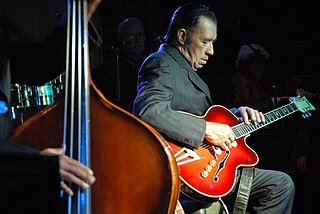
Manuel Galbán was a Grammy-winning Cuban guitarist, pianist and arranger, most notable for his work with Los Zafiros, Ry Cooder and the Buena Vista Social Club. He died on July 7, 2011, of cardiac arrest at his home in Havana, Cuba.
Fryette Amplification of North Hollywood, California is a manufacturer of hand-built electric guitar amplifiers, speaker cabinets, power amplifiers, sound effects pedals and pedalboard accessories. The company was founded as VHT Amplification in Studio City, Los Angeles, California by Steven Fryette in January 1989 and was the first to produce a true three-channel vacuum tube amplifier.

Pull Up Some Dust and Sit Down is the fourteenth studio album by American singer-songwriter and multi-instrumentalist Ry Cooder. It was released by Nonesuch Records on August 30, 2011, and written and produced by Cooder, who recorded its songs at Drive-By Studios, Ocean Studios, and Wireland Studios in California. He played various instruments for the project while working alongside studio musicians such as Flaco Jiménez, Juliette Commagere, Robert Francis, and Jim Keltner.

Election Special is the 15th studio album by American singer-songwriter and multi-instrumentalist Ry Cooder. It was released on August 16, 2012, by Perro Verde and Nonesuch Records. Cooder recorded and produced the album mostly at Drive-By Studios in North Hollywood, performing all of the instrumentation, including bass, guitar, and mandolin, with the exception of drums, which were played by his son Joachim.

The Slide Area is the tenth studio album by Ry Cooder. It was released in 1982 and peaked at No. 105 on the Billboard 200.


















